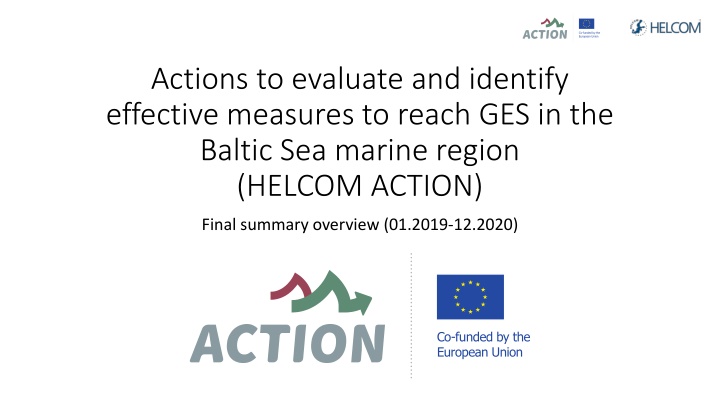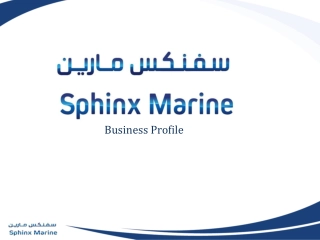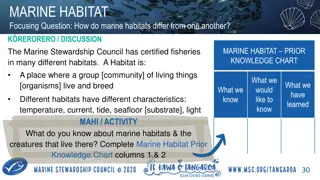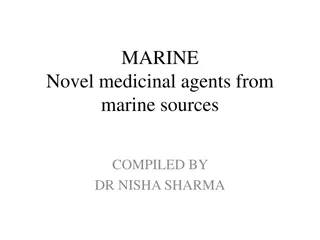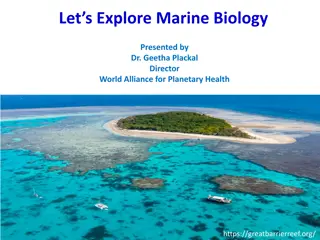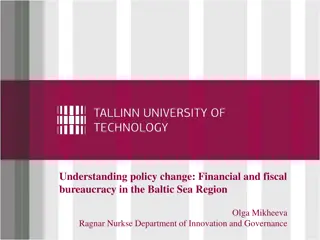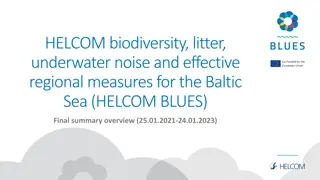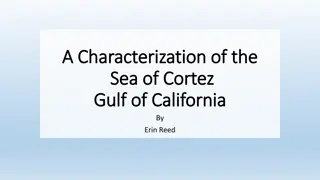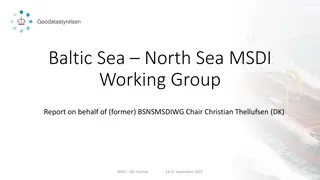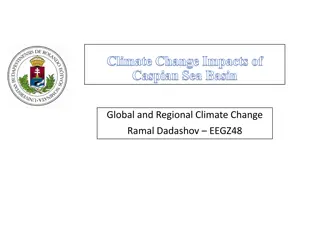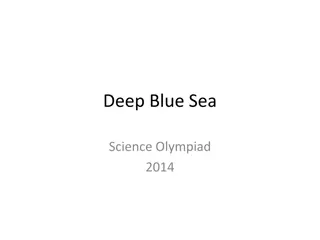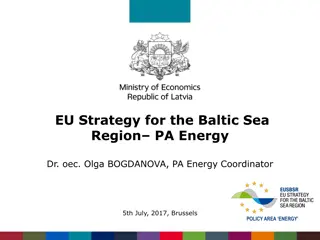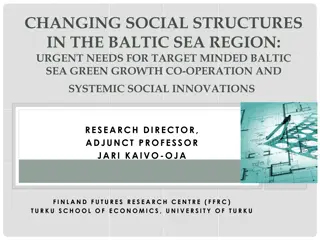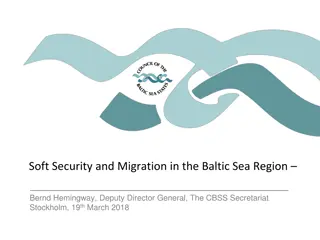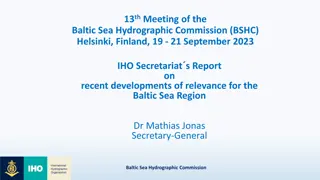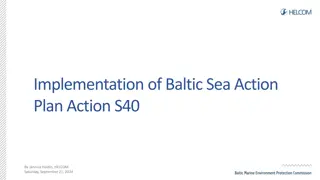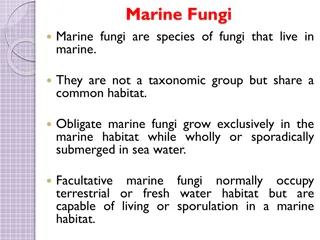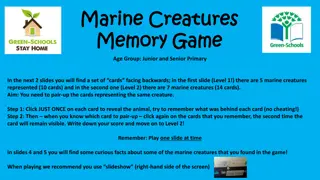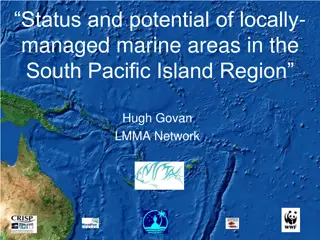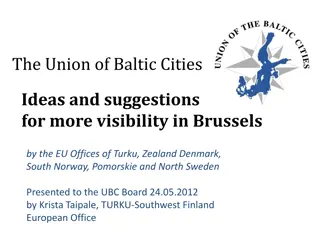Effective Measures for GES in the Baltic Sea Marine Region
This project, co-funded by the European Union, aims to evaluate and identify effective measures to achieve Good Environmental Status (GES) in the Baltic Sea marine region. Partners and sub-contractors are working on methodologies for bycatch assessment and impact on the seabed, including restoration efforts. Key findings highlight significant levels of bycatch, the need for improved data reporting, and restoration initiatives for eelgrass and soft bottom macrophytes.
Download Presentation

Please find below an Image/Link to download the presentation.
The content on the website is provided AS IS for your information and personal use only. It may not be sold, licensed, or shared on other websites without obtaining consent from the author.If you encounter any issues during the download, it is possible that the publisher has removed the file from their server.
You are allowed to download the files provided on this website for personal or commercial use, subject to the condition that they are used lawfully. All files are the property of their respective owners.
The content on the website is provided AS IS for your information and personal use only. It may not be sold, licensed, or shared on other websites without obtaining consent from the author.
E N D
Presentation Transcript
Co-funded by the European Union Actions to evaluate and identify effective measures to reach GES in the Baltic Sea marine region (HELCOM ACTION) Final summary overview (01.2019-12.2020) Co-funded by the European Union
Co-funded by the European Union Grant information Programme concerned: MARINE STRATEGY FRAMEWORK DIRECTIVE - SECOND CYCLE: IMPLEMENTATION OF THE NEW GES DECISION AND PROGRAMMES OF MEASURES Reference number of the call for proposals: DG ENV/MSFD 2018 call Title of the project: Actions to evaluate and identify effective measures to reach GES in the Baltic Sea marine region (HELCOM ACTION) Grant agreement number: 110661/2018/794637/SUB/ENV.C2
Co-funded by the European Union Partners Beneficiary of grant agreement: Baltic Marine Environment Commission HELCOM 2.1 Finnish Environment Institute (SYKE) 2.2 Technical University of Denmark (DTU) 2.3 Aarhus University (AU) 2.4 Tallinn University of Technology (TTU) 2.5 Swedish Agency for Marine and Water Management (SwAM) 2.6 Swedish University of Agricultural Sciences (SLU) 2.7 University of Tartu, Estonia (UT) 2.8 Klaip da University, Marine Research Institute (KU) Sub-contractors: Baltic Nest Institute (BNI), Sweden; AKTiiVS, Latvia; and Bionautit, Finland.
Co-funded by the European Union WP1: Bycatch Methodology developed for applying risk mapping different data types used
Co-funded by the European Union Bycatch Key findings Significant levels of bycatch estimated for mammals and birds in all assessed areas Different methodologies applied to accommodate data specificities when producing risk maps Larger bycatch estimates than previous studies likely due to inclusion of fishing effort of smaller vessels (smaller vessels being a large component of the Baltic fleets) Total bycatch mortality estimates likely underestimated in certain regions due to missing effort from other countries active in those regions First costing of large scale pinger application in the Baltic Sea Need for further data and reporting improvements for improved bycatch assessment (actual and risk maps)
Co-funded by the European Union WP2: Impacts on the seabed Restoration of eelgrass, Zostera marina Restoration of soft bottom macrophytes Restoration of brown macroalgae Restoration of blue mussel reefs Restoration of stony reefs Restoration of soft bottoms naturally free of vegetation Restoration of coastal wetlands and fladas/lagoons Strengthening piscivorous fish Reducing nutrient loading - blue mussels Rehabilitation of hypoxic areas by oxygen pumping Reducing internal phosphorus loads by metal binding Investigative and trial biomanipulation Rehabilitation of anoxic, nutrient rich or polluted Restoration Displacement of fishing effort sediments Establishment of artificial reefs Protection of habitats Follow-up and knowledge sharing
Co-funded by the European Union Seabed Key findings Most extensive pressures, having highest potential impact, include physical disturbance to seabed, eutrophication and hazardous substances. Critical to better understand the activities and pressures plus their corresponding sensitivities and thus impact to further develop stronger assessments. Understanding will also help develop appropriate mitigation approaches. Generally, preventing damage is more effective and cost-effective than restoration. 17 restoration measures and their cost and effectiveness reviewed. Spatial fisheries management, based on the current modelling approaches and available information appear to indicate minimal improvements in status (compared to comparative studies in the Kattegat, North Sea side). A viable model for the implementation (and further development) of spatial fisheries management is available. A large number of coastal restoration measures are available and viable in the Baltic Sea, though effective placement is important, and impacts may be on local scales, at least initially.
Co-funded by the European Union WP3: Marine Protected Areas Methodology to assess management effectiveness of the Baltic Sea MPS network (adapted from IUCN-WCPA (International Union for Conservation of Nature -World Commission on Protected Areas))
Co-funded by the European Union MPAs Key findings Three quarters of human activities are relevant to more than half of the MPAs assessed. Most of the assessed human activities were addressed by other management instruments, not the specific MPA management plans. Management of the activities is generally high in a large percentage of the MPAs, however management of fishery activities differ substantially among habitats and part of human activities (e.g. shipping, fishery by bottom contacting gears) are managed to a different degree in different countries. Higher number of unmanaged or partly managed human activities is observed in MPAs with terrestrial component. Fishery with towed bottom contacting gear (in specific sub-region) have specific management plans that differ from general approach. Human activities based on infrastructure are better managed compared to more spatially diffuse human impacts, even if the two could be considered directly associated (e.g. transport infrastructure and shipping). The applied approach provides important insights into the possibility to assess management effectiveness of the Baltic Sea MPA network. Improvements to the approach to hone the process and improve the spatial coverage would facilitate even stronger findings and unpick more subtle trends or results.
Co-funded by the European Union WP4: Inputs of nutrients PTOT Year 2000 Total 2570 tons PTOT Year 2018 Total 1030 tons Inputs of nutrients from municipal waste water treatment plants (WWTPs) have decreased in recent times, however there remains high potential for further reductions. 8 % 10 % Municipalities 25 % Municipalities Industry 28 % Industry Aquaculture Aquaculture 62 % 67 % Figure 4. Direct point source PTOT loads by sources in 2000 (left) and 2018 (right).
Co-funded by the European Union Nutrients Key findings As much as 10% of the BSAP reduction targets could be achieved if all WWTPs followed HELCOM recommendation 28E/5 fully. Data was reviewed, updated and improved in the HELCOM Pollution Load Compilation (PLC) as a result of the analysis carried out. Data harmonization needs and limitations were also identified, as well as recommendations on possible improvements for future iterations of PLC (e.g. inclusion of supporting parameters such as measures applied in an area). Discrepancies between Water Framework Directive (WFD) targets in coastal areas and Baltic Sea Action Plan (BSAP) targets were identified in certain areas, i.e. where for example WFD targets are not sufficient to achieve the BSAP aims (e.g. in the Baltic Proper or Gulf of Finland). Where discrepancies occurred they were generally larger for phosphorus. Recommendations were made on how to improve and harmonise these policy initiatives.
Co-funded by the European Union WP5: Natural conditions and GES Substances Metals (Hg, Pb, Cd) Examples of natural conditions influencing achieving of GES Catchment area soil concentrations Land use changes Urbanization Increased runoff and storms/flooding Sediment disturbance TBT has a high degradation rate in the water column, but it is low in sediments. Persistence of butyltin compounds in sediments can be enhanced by high salinity, low temperature, high organic matter content, etc. Long half-life of TBT: deep-sea sediment (8 5 years) and 87 17 years for the deep anoxic layer. Re-dispersal by periodical dredging of the port channels and shipping routes Due to their continuous discharge into the environment through different entry paths, pharmaceuticals are regarded as a class of pseudo-persistent contaminants. Highly persistent, especially long-chain PFASs (e.g. PFOS and PFOA). Environmental PFOS concentrations have not yet declined as a response to reduced emissions. Estimated time lag 20 30 years. TBT 8-80 years. Pharmaceuticals No current evidence of long time lags. PFOS (PFASs) Not estimated, but highly persistent.
Co-funded by the European Union Natural conditions Key findings Limited commonality was observed in the reporting of exceptions under the MSFD by HELCOM Contracting Parties that are also EU Member States. The highest number of countries indicated the exceptions of not achieving GES regarding D5 eutrophication and D8 contaminants. Also, the GES Descriptors related to species and habitats, as D1 biodiversity, D2 non-indigenous species, D3 commercial fish, D4 food webs, and D6 seabed integrity, were reported. The internal load of accumulated nutrients from sediments was indicated as the main reason for not achieving GES under D5 eutrophication. For both eutrophication and contaminants, retention of substances in the drainage area, accumulation in sediments and limited water exchange were mentioned. Time lags for achieving GES after the measures were implemented were commonly not estimated and reported.
Co-funded by the European Union WP6: Sufficiency of measures General schematic of the main components of the SOM analysis. Conceptual illustration of the SOM analysis.
Co-funded by the European Union SOM Key findings A conceptual and operational framework for assessing effectiveness and sufficiency of measures to achieve state improvements, flexible enough to accommodate various data availability (from expert-based evaluations through to full quantitative assessment) is described. The methodology is constructed around a causal framework, linking measures, activities, pressures and subsequently state; estimating the gap to achievement of good environmental status/state improvements. Three pressures, eutrophication, extraction of species (incl. prey depletion) and human induced food web imbalance, are identified as predominant drivers of change for the Baltic Sea ecosystem. In general, the results indicate that existing measures are likely not sufficient to reach GES for most of the analysed pressures/state components, which are currently not in good status. The results suggest that progress is being made and that existing measures are projected to lead to significant pressure reductions by 2030, if they are fully implemented. The proposed new measures were estimated to further reduce the pressures by 2030; the highest reductions were estimated for seabed disturbance. It was shown that the probabilities to reach good state (or improve the state) increased for almost all state components. Among the proposed new measures, the spatial protection measures were the ones addressing most of the pressures and were also considered effective if they truly regulate human activities within the areas, e.g. fisheries, boating, tourism and construction.
Summary of output as of March 2021 Co-funded by the European Union 25 project reports, 1 summary report 6 workshops and outcomes >20 synopses to BSAP update process (proposals on new actions/measures) 1 peer reviewed publication completed (at least 8 under preparation from WPs 2, 3, 4, 5 and 6) 2 HELCOM reports approved so far Developed methodologies Input to national, regional and international processes (and new projects/applications)
Co-funded by the European Union Co-funded by the European Union
